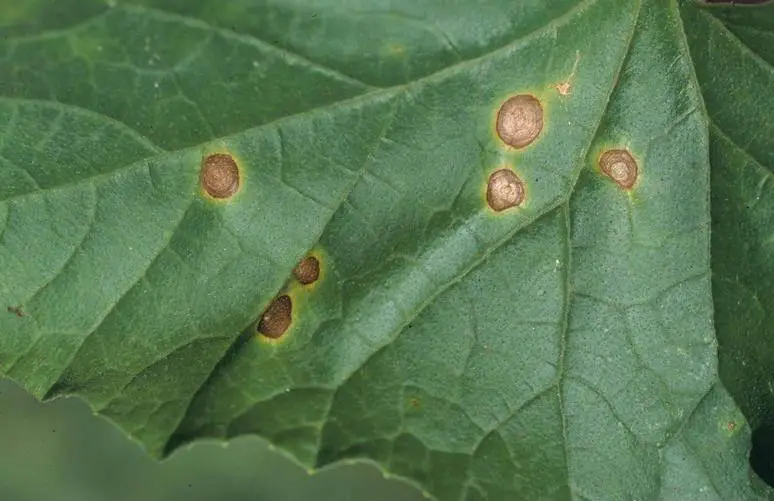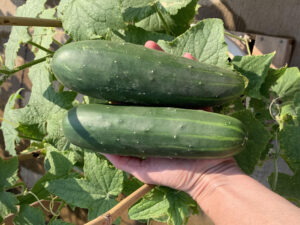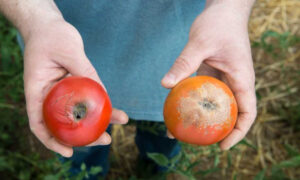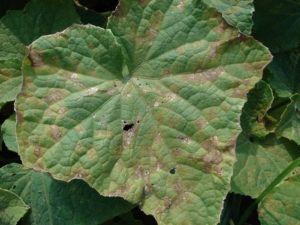Nothing tastes better than a salad featuring homegrown lettuce, tomatoes, and cucumbers! But cucumbers, like other garden favorites, are susceptible to diseases like powdery mildew, downy mildew, and anthracnose. In this article, we will learn about Alternaria or early blight, another disease that can affect cucumbers and other cucurbits like watermelon, cantaloupe, zucchini, acorn squash, and butternut squash, and non-cucurbits like tomatoes. (early blight in tomatoes article)
How to Identify Early Blight (Alternaria) in Cucumbers
Early blight or Alternaria (Alternaria cucumerina) is characterized by dry, tan, or brown irregularly shaped spots on leaves that are encircled with a yellow halo. These concentric circles usually affect older leaves first, although this is not always the case. As the disease progresses, leaves will eventually turn yellow, decay, and fall off.
Cucumber early blight can affect the entire plant including foliage, stems and sometimes fruit. If it does infect the cucumbers, it may display dark, water-soaked spots on the skin, while the stems may develop dark brown spots or cankers. While the disease does not usually kill the plant outright, it will negatively affect the overall health and growth of the plant and, thereby, cucumber production.
Conditions That Favor Cucumber Early Blight
Alternaria is often referred to as early blight because it tends to appear earlier in the season when spring temperatures are warming up. The fungal spores are activated by temperatures as low as 60°F (15° C) but are most prolific at 80°F ( C) and above. Moist or humid conditions further enhance the pathogen’s ability to reproduce, as does plant malnutrition, especially a lack of nitrogen.
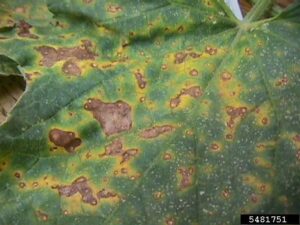
How to Prevent Alternaria
There are several steps you can take to help prevent Alternaria or early blight, although nothing is 100% effective.
- Purchase certified seeds and plant starts.
- Inspect all transplants before adding them to your garden.
- Plant cucumber varieties that are resistant to this pathogen.
- Practice crop rotation with a minimum two year cycle.
- Plant seeds/plants with adequate space in between to allow for more air flow and less contact between plants.
- Prune branches as plants mature to maintain good air flow.
- Use a trellis or tomato cage to help keep leaves off of the ground.
- Water from the bottom to minimize water splashing the soil and dispersing spores.
- Practice good garden hygiene by cleaning garden tools in between plant use.
- Remove and dispose of plant debris. Do not compost infected leaves, plants, or fruit.
How To Treat Early Blight (Alternaria)
There is no cure for Alternaria, however, with early treatment, the disease can be managed. Here are some steps you can take:
1. Prune Infected Plant Tissue – Remove infected leaves, stems, and fruit and dispose of in the trash. Do not compost them as most compost piles do not maintain high enough temperatures to kill the pathogen.
2. Disinfect – Disinfect garden tools and any other items that may have been in contact with an infected plant.
This article contains affiliate links. If you make a purchase using one of these links, I will receive a very small commission at no additional cost to you, and it will help me maintain this website. Rest assured, I only recommend products I actually like!
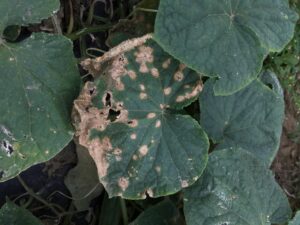
3. Apply An Antifungal Agent – Here are two DIY recipes for antifungal sprays:
DIY Peroxide Spray – Add 8 tablespoons (1/2 cup) of 3% hydrogen peroxide and one gallon of water to a one-gallon sprayer. Shake well. Perform a test on a few leaves before spraying the entire plant since hydrogen peroxide can burn plant tissue. If plant tissue does not show any damage after 24 to 48 hours, proceed to treat the entire plant, including under the leaves and any fruit. If damage does occur, reduce the amount of hydrogen peroxide in the solution and retest.
If there is an active fungal infection, spray plants for two to three consecutive days, followed by once every two weeks as a preventative measure. You may need to adjust the spraying schedule as not all plants respond the same way. If you find that the mixture is not particularly effective, you can increase the amount of hydrogen peroxide in 1 tablespoon increments, not to exceed a total of 12 tablespoons per gallon of water.
DIY Baking Soda Spray – Add one to two tablespoons of baking soda, one teaspoon of vegetable oil, a few drops of a chemical free soap like Dr. Bonner’s, and one gallon of water to a one gallon prayer. Shake well.
Just as in the DIY peroxide spray (above), perform a test on a few leaves. If, after 24 to 48 hours, there is no damage, spray the plant, including the underside of leaves, fruit, etc. Reapply every few days to keep the spores at bay or about once a week as a preventative measure.
Early blight in cucumbers is a common disease that affects other cucurbits and nightshades such as tomatoes. It can kill a plant if left untreated. However, with proper management, you should still be able to enjoy a harvest!
Thank you for reading this article! If you found it helpful, please consider sharing it with others via email and social media!
